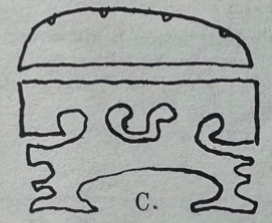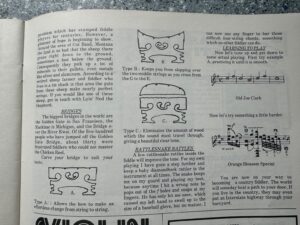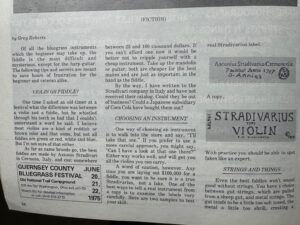WOTFA Wayback – Fiction by Greg Roberts
Of all the bluegrass instruments which the beginner may take up, the fiddle is the most difficult and mysterious, except for the harp-guitar. The following tips and secrets are meant to save hours of frustration for the beginner and veteran alike.
VIOLIN OR FIDDLE?
One time I asked an old-timer at a festival what the difference was between a violin and a fiddle, but he whistled through his teeth so bad that I couldn’t understand a word he said. I believe most violins are a kind of reddish or brown color and that some, but not all fiddles are green or red, white and blue. But I’m not sure of that either.
As far as name brands go, the best fiddles are made by Antonio Stradivari in Cremona, Italy, and cost somewhere between 25 and 100 thousand dollars. If you can’t afford one now it would be better not to cripple yourself with a cheap instrument. Take up the mandolin or guitar; both are cheaper for the best makes and are just as important in the band as the fiddle.
By the way, I have written to the Stradivari company in Italy and have not received their catalog. Could they be out of business? Could a Japanese subsidiary of Coca Cola have bought them out?
CHOOSING AN INSTRUMENT
One way of choosing an instrument is to walk into the store and say, “I’ll take that one.” If you prefer to use a more careful approach, you might say, “Can I have a look at that one there?” Either way works well, and will get you all the violins you can carry.
A word of caution, however. Any time you are laying out $100,000 for a fiddle, you want to be sure it is a true Stradivarius, not a fake. One of the best ways to tell a real instrument from a copy is to examine the labels very carefully. Here are two samples to test your skill:

[Label 1 – Real Stradivarius]
Antonius Stradivarius Cremonensis
Faciebat Anno 1737
D. Arni93
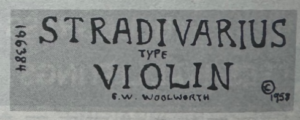
[Label 2 – Fake]
STRADIVARIUS TYPE VIOLIN
C.W. Woolworth
1959
With practice you should be able to spot fakes like an expert.
STRINGS AND THINGS
Even the best fiddles won’t sound good without strings. You have a choice between gut strings, which are pulled from a sheep gut, and metal strings. The gut tends to be a little too soft toned, the metal a little too shrill, creating a problem which has stumped fiddle players for centuries. However, a glimmer of hope is beginning to show. Around the area of Cut Band, Montana the land is so bad that the sheep there graze right down to the ground, sometimes a foot below the ground. Consequently they pick up a lot of minerals in their gullets, even metals like silver and aluminum. According to a retired sheep farmer and fiddler who lives in a tin shack in that area the guts from these sheep make nearly perfect strings. If you would like one of these sheep, get in touch with Lyin’ Ned the Shepherd.
BRIDGES
The biggest bridges in the world are the Golden Gate in San Francisco, the Mackinac in Michigan, and the Bridge over the River Kwai. Of the five-hundred people who have jumped off the Golden Gate Bridge, about thirty were frustrated fiddlers who could not master the Chicken Reel.
Carve your bridge to suit your taste.
Type A: Allows the bow to make an effortless change from string to string.

Type B: Keeps you from slopping over the two middle strings as you cross from the G to the E.
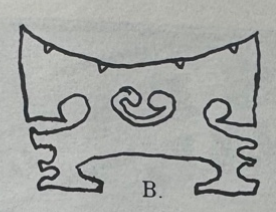
Type C: Eliminates the amount of wood which the sound must travel through, giving a beautiful clear tone.
RATTLESNAKE RATTLES
A few rattlesnake rattles inside the fiddle will improve the tone. For my own playing I have gone a step further and keep a baby diamondback rattler in the instrument at all times. The snake keeps me on my guard and playing my best, because anytime I hit a wrong note he pops out of the f holes and snaps at my fingers. He has only hit me once, which caused my left hand to swell up to the size of a baseball glove, but no matter. I can now use any finger to bar those difficult four-string chords, something which no other fiddler can do.
LEARNING TO PLAY
Now let’s tune up and get down to some actual playing. First try example A, practicing it until it is smooth.

Old Joe Clark (musical notation shown)
Now let’s try something a little harder.

Orange Blossom Special (complex musical notation shown)
You are now on your way to becoming a country fiddler. The world will someday beat a path to your door. If you live in the country, they may even put an Interstate highway through your barnyard.
Original Photographs from Bluegrass Unlimited, courtesy of John Loder
